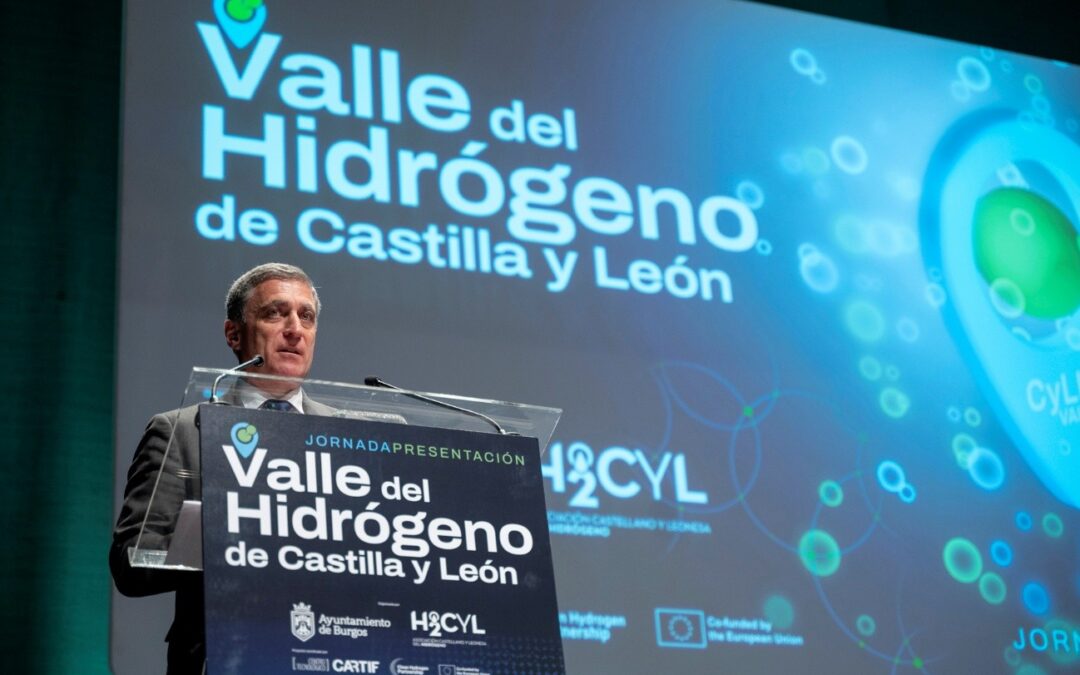National experts and companies from the sector met today at the Fórum Evolución in Burgos in a conference open to the public to explain the Castilla and Leon Hydrogen Valley Project analyse the Spanish infrastructure and highlight several success stories of European companies working in the different phases of the hydrogen value chain.
The conference, organised by Burgos City Council and the Castilla and Leon Hydrogen Association (H2CYL), has served as a starting point for the Castilla and Leon project, which has the backing of Europe and an estimated total investment of 380 million euros. Its objective is to convert the region into the main integrated green hydrogen ecosystem in Spain and to covet its entire value chain, from production to compression, distribution and storage.
During the meeting, attendees were able to learn about the technical aspects of the project through various presentations and round tables, after the institutional opening by the Mayor of Burgos City Council, Cristina Ayala, who was accompanied by José Miguel García, Rector of the University of Burgos; José Ramón Perán, Chief Executive Officer of CARTIF and Valérie Buillon-Delporte, Director of the Clean Hydrogen Partnership. Bouillon-Deplorte pointed to the leading role of this project in the future of renewable hydrogen in Europe. “The support we are giving to the Hydrogen Valley of Castilla and Leon from Europe with almost 20 million grant will boost this initiative, with nine pioneering pilot projects in the hydrogen value chain, perfectly aligned with our mission to accelerate innovation and drive European competitiveness towards green energy” she said.
Thereafter, it was the turn of Rafael Barbero, President of H2CYL, who explained how this project “marks a milestone in our commitment to green hydrogen as an engine for sustainable development, industrial innovation and the creation of quality employment”, as well as pointing out that it places the community of Castilla and Leon “at the forefront of the energy transition in Spain”. Barbero also referred to the challenges of the project, pointing out “the creation of a powerful consumer network, cooperation with other initiatives in the area, the promotion of new valleys, the attraction of new industry, technical development and the development of replication plans”, he said.
Sergio Sanz, Deputy General Manager of CARTIF, was in charge of talking about the technical aspects of the project. Specifically, Sanz recalled that the Hydrogen Valley will be developed in three major phases, will have a production capacity of more than 16,800 tonnes of green hydrogen per year, will reduce up to 152,000 tonnes of CO2 per year by replacing fossil fuels in key sectors and will create 2,000 direct and indirect jobs.
“With this project, we are going to demonstrate that it is possible to use green hydrogen on a large scale in Castilla and Leon”, said Sanz, who went on to explain the advantages offered to the autonomous community: “This region stands out for its strategic leadership in renewable energies, its strong political and industrial commitment and its solid ecosystem for innovation. In addition, it has an optimal location for infrastructure and logistics, and a potential socio-economic impact”, he added.
The day continued with the round table ‘Hydrogen Valley, the actors of change’, where María Jaén, European Hydrogen Research Leader of EPRI; Andrés Hernando, Chief Executive Officer of Hiperbaric; Alfonso Arroyo, general manager of Ente Regional Energy Agency; and Raúl Rodríguez, Commercial Director of TRESCA talked about the steps to follow to maximise the effect of the initiative. “This project responds to our aim of creating professional and personal development opportunities for all our stakeholders and is a clear example of what needs to be done to create opportunities in Castilla and Leon”, said Hernando.
Alfonso Arroyo recalled the need to bet “on what can be produced in the region” because “the competitiveness of the industry will hinge on indigenous sources of energy, and hydrogen is an opportunity for the region”, explained Arroyo.
Hydrogen infrastructure in Spain
José Luis Casarrubios, Hydrogen Infrastrcutrure Project Manager at ENAGÁS, spoke in depth about hydrogen infrastructure in Spain. During his speech, Casarrubios highlighted Spani’s capacity to generate green hydrogen.
The analysis forum also included the testimony of several European Companies that presented their success stories in the implementation of hydrogen technologies in all phases of the value chain, such as Javier Quiñones, R&D Executive Director at CUIDEN; Xavier Ribas, Director of Innovation at EVARM; Franz Bechtold, Spanis Sales Director at Lhyfe and Alasdair Leapman, European Sales Director at Plug Powe.
The day ended with a visit to Hiperbaric Company in Burgos to learn about the design and operation of Hiperbaric’s high-pressure compressor technology, Aciturri’s high-pressure store tanks and fire safety equipment in H2 installations from Komtes Group.
